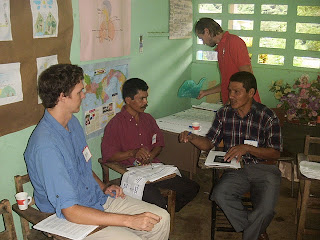I’m reading David McCullough’s very well-written account of the saga behind the building of the Panama Canal, The Path between the Seas. The following is a passage from the book. The words in parenthesis have been added in by me.
---------------
The dry season, with its clear skies and trade winds, begins normally about mid-December and lasts four months... Then, abruptly, about the first of May, the rains return. It does not rain all the time in the wet season, as many suppose. In a country where an inch of rain can fall in an hour, 120 or 130 inches of rain in a year may not mean a great many more than 120 or 130 hours of rain all told. Some of the most torrential downpours last only a few minutes. At Colon (my provincial capitol), six inches in twenty four hours or less is not uncommon. In the single month of November, when the heaviest storms strike, rainfall along the Chagres basin (again, my area) could range from 2 to 3 feet.
But no statistic conveys a true picture of the Panama rain. It has to be seen, to be felt, to be smelled; it has to be heard to be appreciated. The effect is much as though the heavens have opened up and the air has turned instantly liquid.
The skies, when it is not raining, are always nearly filled with tremendous, towering clouds- magnificent clouds, and especially so in the light of early morning. Then there will be an unmistakable rush of wind in the trees, a noticeable drop in temperature, a quick darkening overhead followed by a sound that someone likened to the “trampling of myriad feet” through leaves (as the storm approaches)...
If one were to wait out the storm beneath a corrugated iron roof (or a zinc one like my house has), the sound is like that of a locomotive. Often these storms become violent thunderstorms, with lightning “so stunning,” wrote one American (employee of the canal company), “it just makes a person feel as though he were drunk.” And then, while the trees still toss and roar, the rain would be over- in an instant. The sun will be out again, fierce as ever. Everything will glisten with rainwater and the air will be filled with the fecund, greenhouse smell of jungle and mud.
------------
I read this yesterday, and it seemed like a particularly apt thing to write in my blog now that we are in the month of November; the height of the wet season. Last week was almost constant rain for 5 days, though it did not always fall with the ferocity described here. This and last year have been described to me as mild winters and it is hard for me to imagine what a severe one is like. There is no such thing as “May showers” here.
nu=3274)9+5%29%3B%285%29WSNRCG%3D344+3+65%3B932%3Bnu0mrj.jpg)
nu=3274)9+5%29%3B%285%29WSNRCG%3D344+3+923532%3Bnu0mrj.jpg)
nu=3274)9+5%29%3B%285%29WSNRCG%3D344+3%3B%3B8%3B532%3Bnu0mrj.jpg)


nu=3274)9+5%29%3B%285%29WSNRCG%3D344+3966%3B232%3Bnu0mrj.jpg)
nu=3274)9+5%29%3B%285%29WSNRCG%3D344+42679632%3Bnu0mrj.jpg)
nu=3274)9+5%29%3B%285%29WSNRCG%3D344+42767432%3Bnu0mrj.jpg)
nu=3274)9+5%29%3B%285%29WSNRCG%3D344+42764+32%3Bnu0mrj.jpg)






























